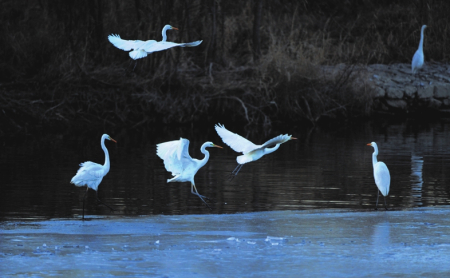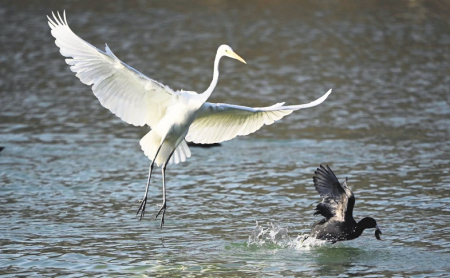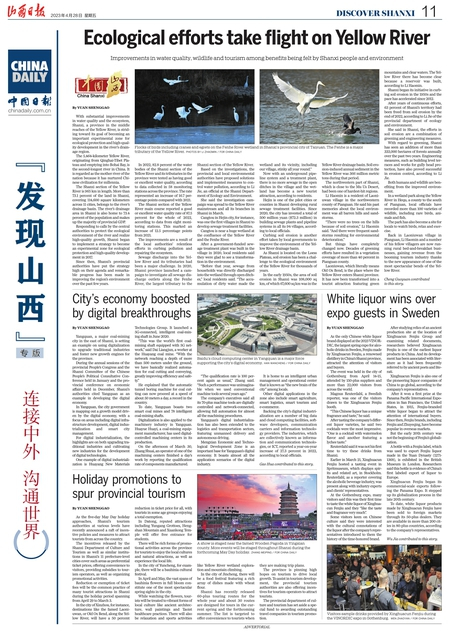Ecological efforts take flight on Yellow River
Improvements in water quality, wildlife and tourism among benefits being felt by Shanxi people and environment


Flocks of birds including cranes and egrets on the Fenhe River wetland in Shanxi’s provincial city of Taiyuan. The Fenhe is a major tributary of the Yellow River. Photos by Li Zhaomin / For China Daily
With substantial improvements in water quality and the ecosystem, Shanxi, a province in the middle reaches of the Yellow River, is striding toward its goal of becoming an important experimental zone for ecological protection and high-quality development in the river's drainage region.
The 5,464-kilometer Yellow River, originating from Qinghai-Tibet Plateau and emptying into Bohai Bay, is the second-longest river in China. It is regarded as the mother river of the nation because it has nurtured Chinese civilization for millennia.
The Shanxi section of the Yellow River is 965 km in length. More than 73.1 percent of the land in Shanxi, covering 114,600 square kilometers across 11 cities, belongs to the river's drainage basin. The river's drainage area in Shanxi is also home to 73.4 percent of the population and makes up the majority of provincial GDP.
Responding to calls by the central authorities to protect the ecological environment of the river and realize high-quality growth, Shanxi began to implement a strategy to become an experimental zone for ecological protection and high-quality development in 2017.
Since then, Shanxi's provincial authorities have put the strategy high on their agenda and remarkable progress has been made in improving the region's environment over the past few years.
In 2022, 82.8 percent of the water bodies of the Shanxi section of the Yellow River and its tributaries in the province were tested as having good or excellent water quality, according to data collected in 58 monitoring stations across the province. The rate represented an increase of 16.7 percentage points compared with 2021.
The Shanxi section of the Yellow River main course reported a good or excellent water quality rate of 87.5 percent for the whole of 2022, according to data from eight monitoring stations. This marked an increase of 12.5 percentage points from 2021.
The improvements are a result of the local authorities' relentless efforts in curbing pollution and repairing the ecosystem.
Sewage discharge into the Yellow River and its tributaries had been a major challenge. In 2020, Shanxi province launched a campaign to investigate all sewage discharge outlets along the Fenhe River, the largest tributary to the Shanxi section of the Yellow River.
Based on the investigations, the provincial and local environmental authorities have proposed solutions and implemented measures to control water pollution, according to Li Jie, an official at the Shanxi Department of Ecology and Environment.
She said the investigation campaign was spread to the Yellow River mainstream and all its branches in Shanxi in March.
Cangtou in Hejin city, for instance, was one the first villages in Shanxi to develop sewage treatment facilities.
Cangtou is near a huge wetland at the confluence of the Yellow River and the Fenhe River.
After a government-funded sewage treatment plant was built in the village in 2020, local residents said they were glad to see a transformation in the environment.
"Before that year, sewage from households was directly discharged into the wetland through open ditches," local residents said. "The accumulation of dirty water made the wetland and its vicinity, including our village, stinky all year round."
Now with an underground pipeline system and a treatment plant, there is no more sewage in the open ditches in the village and the wetland has become a new tourist attraction, according to residents.
Hejin is one of the pilot cities and counties in Shanxi developing rural sewage treatment facilities. Since 2020, the city has invested a total of 500 million yuan ($72.3 million) in building sewage plants and pipeline systems in all its 94 villages, according to local officials.
Curbing soil erosion is another effort taken by local governments to improve the environment of the Yellow River drainage basin.
As Shanxi is located on the Loess Plateau, soil erosion has been a challenge to the ecological environment of the Yellow River for thousands of years.
In the early 1950s, the area of soil erosion in Shanxi was 108,000 sq km, of which 67,600 sq km was in the Yellow River drainage basin. Soil erosion-induced annual sediment in the Yellow River was 366 million metric tons during that period.
The northwestern part of Shanxi, which is close to the Mu Us Desert, had been one of hardest-hit regions.
Li Haomin is a resident of Laoniuwan village in the northwestern county of Pianguan. He said his past memories about the local environment was all barren hills and sandstorms.
"There were no trees on the hills because of soil erosion," Li Haomin said. "And there were frequent sandstorms resulting from environmental deterioration."
But things have completely changed now. Decades of greening efforts have resulted in a vegetation coverage of more than 40 percent in Pianguan county.
Laoniuwan, which literally means old ox bend, is the place where the Yellow River enters Shanxi province. It has now been transformed into a tourist attraction featuring green mountains and clear waters. The Yellow River there has become clear because a reservoir was built, according to Li Haomin.
Shanxi began its initiative in curbing soil erosion in the 1950s and the pace has accelerated since 2012.
After years of continuous efforts, 63 percent of Shanxi's territory had been freed from soil erosion by the end of 2022, according to Li Jie of the provincial department of ecology and environment.
She said in Shanxi, the efforts in soil erosion are a combination of greening and engineering measures.
With regard to greening, Shanxi has seen an addition of more than 333,000 hectares of forests annually over the past two years. Engineering measures, such as building level terraces and works for gully head protection, have also proved successful in erosion control, according to Li Jie.
Both humans and wildlife are benefiting from the improved environment.
In a wetland park along the Yellow River in Hequ, a county to the south of Pianguan, local officials have recorded more than 100 varieties of wildlife, including rare birds, animals and fish.
The park has also become a site for locals to watch birds, relax and exercise.
Back in Laoniuwan village in Pianguan, Li Haomin and a number of his fellow villagers are now running rural bed-and-breakfast businesses, gaining revenue from the booming tourism industry thanks to the new appearance of one of the most spectacular bends of the Yellow River.
By Yuan Shenggao
Cheng Guoyuan contributed to this story.











